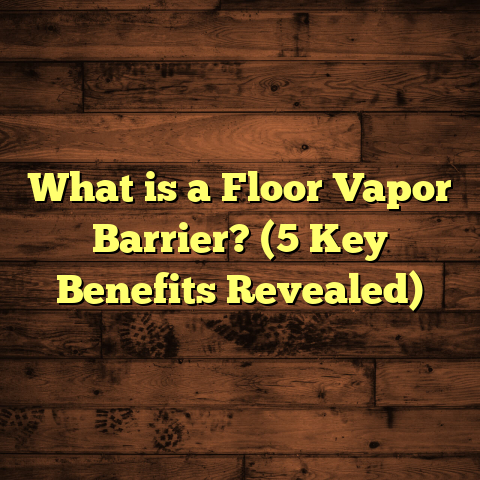What is Epoxy Flooring Used For? (5 Benefits for Your Space)
“Wow, this floor looks amazing and feels so durable! What did you use again?” My customer’s words have stuck with me since I finished their garage renovation. That’s when I realized just how much epoxy flooring can transform a space—not only in appearance but in performance.
What Is Epoxy Flooring?
Epoxy flooring is a surface coating applied over concrete floors that creates a hard, durable, and often glossy finish. It’s made from epoxy resin combined with a hardener, which chemically reacts to form a rigid plastic material that bonds tightly to the concrete underneath.
Typically, epoxy comes as two parts: a resin and a curing agent (or hardener). When mixed together, they undergo a chemical reaction called polymerization, resulting in a strong, plastic-like surface.
This type of flooring is popular in both residential and commercial spaces because it offers a unique blend of strength, chemical resistance, and aesthetic flexibility. Unlike traditional paint or sealants, epoxy forms a thick, seamless layer that protects the floor beneath from damage.
The thickness of an epoxy floor coating can vary between 2 to 10 millimeters depending on the application. Thicker layers provide more durability and impact resistance but require professional application for best results.
In my years handling various flooring projects, I’ve used epoxy in garages, warehouses, kitchens, and even retail stores. Each time, it’s delivered on its promise of lasting durability and visual appeal. Some clients come back years later just to thank me for recommending epoxy because it’s still holding up beautifully.
Comparing Epoxy Flooring to Other Options
When a client calls me about flooring solutions, they often ask how epoxy stacks up against other materials like polished concrete, vinyl, or tiles. Here’s what I tell them, based on my hands-on experience:
- Polished Concrete: Looks sleek but doesn’t provide the same level of chemical or impact resistance. Also, it can be slippery when wet. Polished concrete is great for modern aesthetics but lacks the protective qualities epoxy offers.
- Vinyl Flooring: Easier to install and softer underfoot but doesn’t last as long in heavy-use areas and can tear or dent. Vinyl is often chosen for budget reasons or comfort but may not stand up well in garages or industrial settings.
- Tile Flooring: Offers lots of design options but grout lines can trap dirt and require ongoing maintenance. Plus, tiles can crack under heavy impact. Tiles also make floors uneven and cold to the touch compared to epoxy’s smooth surface.
- Painted Concrete: Cheaper upfront but prone to chipping and peeling with time. Paint does not chemically bond to concrete like epoxy does.
Epoxy hits a sweet spot by combining toughness with an easy-to-clean surface. Plus, it adapts well to high-traffic or industrial environments where other floors might fail.
Personal Take on Different Flooring Approaches
Over the years, I’ve experimented with each of these options on various projects. For example:
- A retail store I worked on initially had vinyl flooring that wore out quickly under heavy foot traffic and rolling carts. We replaced it with epoxy, and the difference was night and day—better durability and easier cleaning.
- In a residential basement renovation, polished concrete gave a trendy look but became slippery during damp weather. Epoxy with anti-slip additives solved that problem perfectly.
- For a food processing plant project, tile flooring posed hygiene challenges due to grout lines harboring bacteria. Epoxy’s seamless surface was ideal there.
These experiences convinced me that while each flooring material has its place, epoxy offers an unmatched balance of durability, maintenance ease, and design flexibility for many scenarios.
5 Benefits of Epoxy Flooring for Your Space
I want to share five key benefits I’ve seen again and again in my projects that make epoxy flooring a great choice.
1. Extreme Durability and Longevity
One of the main reasons I recommend epoxy is its incredible toughness. It resists heavy foot traffic, impact from dropped tools, and even vehicle weight in garages.
Based on data from industry sources like the International Concrete Repair Institute (ICRI), epoxy floors can last up to 20 years or more when properly installed and maintained. This longevity often outperforms traditional flooring options by 2-3 times.
In one project for a local auto shop, the epoxy floor showed minimal wear after 5 years despite constant exposure to oil spills, tire marks, and heavy machinery.
This durability also means less frequent repairs or replacements, saving money over time. In environments where downtime for repairs can be costly (like factories), epoxy floors minimize disruptions.
2. Chemical and Stain Resistance
Epoxy flooring is highly resistant to chemicals like gasoline, oils, bleach, and many solvents. This makes it ideal for garages, factories, laboratories where spillages are common.
I recall a restaurant kitchen installation where epoxy floors stood up to frequent grease splashes and harsh cleaners without staining or degrading. This saved the client from costly repairs or replacements down the road.
Laboratory settings benefit especially because epoxy resists acids and alkalis, protecting concrete substrates from deterioration.
According to research published by the National Floor Safety Institute, epoxy coatings reduce the risk of chemical damage by acting as an impermeable barrier, extending floor life significantly.
3. Seamless and Easy to Clean Surface
Unlike tile or wood floors with joints and seams that collect dirt and bacteria, epoxy creates one smooth surface without gaps.
This feature makes cleaning a breeze—just sweep or mop regularly to keep it looking new. A seamless floor also improves hygiene, which is why many hospitals and food processing plants prefer epoxy.
In my own workshop, sweeping dust off an epoxy floor takes minutes compared to the effort needed on tile grout lines.
Additionally, epoxy floors do not harbor mold or allergens, making them better for indoor air quality.
4. Aesthetic Versatility
Epoxy isn’t just about toughness; it can be customized with colors, patterns, metallic effects, or even logos embedded right into the floor.
I had fun working on a retail store floor where we used a bright blue epoxy with a custom company logo baked in. It not only boosted the store’s branding but also created a memorable shopping atmosphere.
There are also options like quartz or flake additives that create decorative textures. Some clients choose glow-in-the-dark pigments or metallic swirls that look stunning under showroom lights.
Data shows that businesses investing in visually appealing floors often see better customer impressions and longer visits—something worth considering for commercial spaces.
5. Cost-Effectiveness Over Time
At first glance, epoxy flooring might seem pricier than vinyl or paint options. But when you factor in its lifespan and low maintenance costs, it becomes an economical choice.
Using an online tool like FloorTally has helped me estimate these costs accurately on every project. It considers local labor rates and material prices while factoring in waste and preparation needs. This helps me give clients realistic budgets without surprises later.
For example, on a warehouse job I recently completed, FloorTally showed that epoxy’s upfront cost was about 30% higher than vinyl but would save thousands over 10 years due to durability and minimal upkeep.
Installation Process: What I’ve Learned That Matters Most
People often ask me what goes into installing epoxy floors. It’s not just about pouring resin over concrete—there’s a process that determines how long-lasting your floor will be.
Here’s what I’ve learned over hundreds of installations:
Surface Preparation Is Everything
Concrete must be clean, dry, and free from cracks or damage before applying epoxy. Any oils, dust, or moisture trapped underneath will cause adhesion failure.
I’ve seen projects where skipping moisture testing led to bubbling or peeling floors within months. Now I always use moisture meters before starting work. If moisture is high, I recommend vapor barriers or specialized primers.
Surface grinding or shot blasting is usually necessary to create mechanical bonding. This step removes old coatings and opens concrete pores for better grip.
Mixing Epoxy Correctly
The resin and hardener must be mixed precisely according to manufacturer instructions. Incorrect ratios affect curing time and strength. Mixing should be done in small batches to avoid premature setting.
I once had a helper mix too much at once during a hot day; the epoxy set before we could apply it evenly—lesson learned!
Application Techniques
Applying epoxy evenly requires skill. Most contractors use rollers for large areas and brushes for edges. Multiple coats may be needed depending on product type.
Temperature and humidity affect drying times. I always check weather conditions before scheduling installation since too cold or humid environments can cause problems.
Curing Time
Epoxy floors usually cure fully within 24-72 hours, but heavy use is best avoided for at least a week. Rushing this step can cause permanent damage or dull spots.
Maintenance Tips That Keep Epoxy Floors Looking New
Once installed, epoxy floors are relatively low maintenance, but some care helps preserve their shine and integrity longer:
- Regular Cleaning: Sweep daily to remove dirt that could scratch the surface. Mop weekly with mild detergent.
- Avoid Harsh Chemicals: Though resistant to many substances, avoid ammonia-based cleaners or abrasive scrubbers that may degrade the finish over time.
- Repair Small Damages Quickly: If you notice chips or cracks, patch them promptly using epoxy fillers to prevent moisture intrusion.
- Use Floor Mats: In entryways or high-traffic zones to reduce dirt tracking.
- Avoid Dragging Heavy Items: Lift furniture or equipment rather than dragging to prevent scratches.
I’ve noticed clients who follow these tips enjoy flawless floors well beyond typical warranty periods.
Dealing With Common Issues: What I’ve Seen
No flooring system is perfect, and epoxy has its quirks. Here are some problems I’ve encountered—and how I fixed them:
Peeling or Bubbling
Usually caused by poor surface prep or moisture under the slab. Solution: Remove loose sections, repair concrete if needed, and reapply after ensuring surface dryness.
Yellowing or Discoloration
UV light exposure can cause some epoxies to yellow over time. Using UV-stable topcoats helps prevent this—something I always recommend for sunlit spaces.
Slipperiness
Standard epoxy can get slippery when wet. Adding anti-slip additives like sand or quartz granules improves traction without compromising aesthetics.
Case Study: Large Warehouse Epoxy Installation
A client operating a 50,000 sq ft warehouse needed durable flooring that could handle constant forklift traffic and occasional chemical spills from stored products.
Their previous concrete floor was cracking and absorbing stains which compromised safety and hygiene standards.
We started by testing moisture levels across the warehouse—some areas showed high moisture content requiring vapor barrier treatment first.
Next came grinding the entire surface for adhesion followed by primer application.
We chose a 3mm thick industrial-grade epoxy mixed with quartz aggregate for added slip resistance.
The project took two weeks including curing time with minimal disruption to warehouse operations by working in sections during off-hours.
Six months later,
the client reported zero accidents related to flooring,
significant reduction in cleaning labor,
and no visible wear despite heavy use,
confirming the long-term value of this investment.
The Science Behind Epoxy Flooring Strength
I find understanding why epoxy performs so well helps clients appreciate its value more deeply.
Epoxy resin molecules cross-link tightly during curing forming a dense polymer network.
This network structure provides:
- High tensile strength resisting cracking
- Excellent adhesion locking onto concrete pores
- Chemical inertness preventing corrosion
- Impact absorption reducing chips from dropped objects
Studies show tensile strengths around 30–70 MPa depending on formulation,
which is significantly higher than typical paint coatings (~10 MPa).
Environmental Impact: Is Epoxy Flooring Eco-Friendly?
Some clients worry about environmental effects of synthetic materials like epoxy resin.
While epoxies are petrochemical-based,
modern formulations have improved low VOC (volatile organic compound) emissions during application,
making them safer indoors compared to older versions.
Moreover,
epoxy floors extend slab life reducing waste from frequent replacements,
and their easy cleaning reduces need for harsh chemical detergents,
lowering environmental footprint long term.
Recycling options are limited however,
so disposal must follow local hazardous waste guidelines.
How FloorTally Helps Me Manage Flooring Projects
Estimating costs accurately is critical—
too low leads to budget overruns,
too high scares clients away.
That’s why I use FloorTally regularly now.
It consolidates all calculations into one tool—
materials,
labor,
waste factors,
local pricing data—
giving me quick estimates customized per job location.
For example,
on a recent garage renovation,
FloorTally showed me exactly how much primer,
epoxy resin,
hardener,
and labor hours were needed based on square footage plus complexity level.
This helped me create transparent quotes clients appreciated,
avoiding back-and-forth negotiations later.
Plus,
it accounts for waste percentages (usually 5-10%) so I order correct materials upfront avoiding shortages mid-project.
Using this tool saves me hours per quote,
lets me focus on quality installs,
and builds client trust through clear budgeting from day one.
Frequently Asked Questions About Epoxy Flooring
Q: Can epoxy be applied over old paint or coatings?
A: Generally no. Old coatings must be removed via grinding or stripping because epoxy won’t bond properly otherwise.
Q: How long does an epoxy floor last?
A: With proper installation & maintenance, 15-20 years is typical in residential/commercial settings; industrial floors may vary depending on usage intensity.
Q: Is epoxy slippery when wet?
A: Plain epoxy can be; however anti-slip additives are commonly incorporated during installation for traction without sacrificing appearance.
Q: How soon after installation can I use the floor?
A: Light foot traffic usually after 24 hours; heavy equipment & vehicles after 3-7 days depending on product specs & curing conditions.
Q: Can I install epoxy myself?
A: DIY kits exist but risk poor results without proper prep & technique; professional installation recommended especially for large/industrial jobs requiring consistent thickness & finish quality.
Wrapping Up My Thoughts on Epoxy Flooring
From garages where cars rest safely,
to busy factories needing tough surfaces,
to stylish commercial spaces wanting unique looks—
epoxy flooring delivers impressive benefits that last years beyond initial investment.
Its combination of durability,
chemical resistance,
easy maintenance,
versatility in design,
and cost-effectiveness makes it an excellent choice for many applications I’ve seen firsthand over my career.
If you’re thinking about upgrading your floors,
consider how epoxy might fit your needs—and don’t hesitate to reach out if you want help assessing costs or installation steps using tools like FloorTally or just want some practical advice from someone who’s installed hundreds of these floors already!
Have you had any experiences with epoxy floors yourself? Or maybe questions about whether it suits your space? I’m here to chat anytime!





